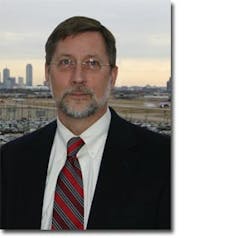Implementing the Wright Pact
DALLAS — On October 13, 2006 the Wright Amendment Reform Act was established to achieve a compromise agreement on the role that Love Field, located just miles from downtown Dallas, would play in the region’s air transportation system. It also cut restraints on airline operations, which in turn led to a 33 percent increase in Southwest Airlines enplanements, due to an expanded ability to connect passengers. But while other airports seek to add gates, Love Field is reducing its number from 32 to 20. As enplanements rise and gates decrease, the challenge today is to reconstruct the main terminal amid ongoing operations, and to build a people mover system that will connect Love passengers to the Dallas Area Rapid Transit, which skirts the airport fence. In time, passengers will be able to connect via train from Love Field to DFW International.
“It’s an expanded niche,” says Daniel T. Weber, A.A.E., director of aviation at Love Field, about the new role of the airfield in the Dallas-Ft. Worth region. “The Metroplex is extremely well served by DFW Airport. What Love Field is is Dallas’s neighborhood airport.
“The big challenge is developing the Love Field Modernization Program and the people mover. We have a staff that’s seasoned. The challenge is, we have to reinvent the airport to convert it from a very region-specific niche market to a facility that serves a nationwide market.”
The airport, which has an annual budget of $42 million, according to Weber, was constructed in 1917 and is land-locked. It has a history of a strong general aviation component, and in fact GA operations (98,000) surpass commercial airline activity (91,000). There are seven fixed base operators, and Gulfstream and Bombardier have completions centers here.
But it’s the Wright agreement that is directing the focus of Weber’s staff. [The Wright Amendment, named for former U.S. House Representative Jim Wright, was put in place to restrict air carrier operations to contiguous states. It was enacted to placate carriers who had moved to the then-new DFW with the understanding that air carrier operations would not return to either Love Field or Ft. Worth’s Meacham Field.]
Comments Weber, “It’s had an impact on the airport — all positive. Almost immediately, Southwest added new destinations from Love Field; through-ticketing was permitted, and that enabled them to add connecting destinations. In March they did a totally restructured schedule and they added 41 new destinations. Enplanements for the fiscal year ending October 1 [2007] were up about 20 percent; but if you look at March ’07 to March ’08, we’re anticipating an additional one million enplanements through the airport.”
Meanwhile, the agreement has served to stabalize the operations of the airport’s other carriers, American and Continental, particularly American. “American adjusted their equipment into Love Field around March,” relates Weber. “They pulled out the MD-80 service and substituted it with American Eagle regional jets. They went down to about 105,000 enplanements for our fiscal ‘07, down from 139,000. That’s about a 25 percent decrease.
“While their enplanements are down, they’re now steady. They’ve probably reached a plateau with which they’re comfortable.”
The redevelopment plan
Love Field recently had its first passenger facility charge approved by FAA, and it is expected to generate some $38 million, according to Weber. Some $29 million of that is reimbursement money for past projects. Weber calls the money a down payment on the modernization program.
The redevelopment effort is being driven by the five-party agreement among the Cities of Dallas and Ft. Worth; Southwest; the DFW Airport Board; and American. Weber explains that the rebuild is mandated to be achieved in collaboration with Southwest. It is still in the early study stages.
Says Weber, “We are obligated to go to 20 gates from the current 32. That will involve demolition of portions of the facility and reconstruction of other portions. The direction we’re going in our planning is to have an option where we phase in a whole new concourse, consolidate all gates into one concourse, and the existing concourses would ultimately be demolished.
“Then there will be relocation and expansion of the ticket hall; and inbound and outbound baggage systems will be redesigned with an inline system. It will effectively be a new concourse and a redeveloped main terminal.
“Concessions will be incorporated into the new configuration, however that turns out.”
It also requires acquisition of the now vacant Legend Terminal, built in the ‘90s by start-up Legend Airlines. Its six gates will be removed. What will happen with the facility and leasehold remains uncertain until the airport can purchase it — held up because of legal challenges. “The issue is the negotiation for the acquisition,” comments Weber.
Connecting to the DART rail system will require tunneling under the airport to install the people mover. Love Field is currently conducting a feasibility study. “DART is currently in a program developing lines to the various different parts of the Metroplex; one of those lines runs alongside Love Field. And we then will have access to DFW, ultimately connecting the two airports,” says Weber.
He and his staff are focused on putting in the elements, step by step, to get the modernization program underway. The PFC was one step; the Legend Terminal resolution is another; and, the others are moving along the studies for the terminal and rail connection.
“The program isn’t really specified other than the fact that it modifies the terminal to conform with the requirements of both the agreement and the act, which is to reduce capacity at the terminal to 20 gates,” he explains. “Beyond that it only speaks in terms of cost magnitude.
“The issue is the phaseout of the Wright Amendment restrictions, which is completed in 2014. So that is our timeline to get these improvements in place.”
“So that’s been the focus of our past year — working out the issues; developing the approach to that project.”
